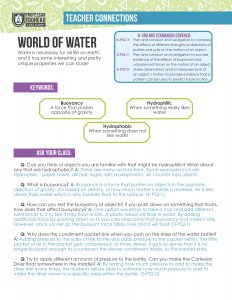Water is an unbelievable substance! Besides being necessary for all life on earth, it also has some interesting properties we can study! Did you know that water actually has a skin on its surface that creates a force called Surface Tension? This week we’ll explore water, surface tension, and make our own submarines at home!
Keywords
- Hydrophilic
- Hydrophobic
- Surface Tension
- Compress
- Buoyancy
materials list
- 2 Bowls of water (½-¾ full)
- Spoon
- Plastic cup
- Dish soap
- Q-Tip
- Pepper (Shaker or 1-2 packets)
- Toilet paper, tissue paper, or paper towel (1 square!)
- Plastic water bottle with lid
- Ketchup packet
background
Life on earth would not exist how we know it if it weren’t for the WATER CYCLE. Water goes through a natural cycle. Cycle - a pattern that repeats over and over again. The water cycle consists of Evaporation, Condensation, Precipitation.
With evaporation, water goes from being a liquid into a gas. This mainly has to do with the liquid water heating up and rising until it has enough energy to escape its liquid state. Here you’ll show a demonstration of hot water rising when mixed with cold water. Whether it’s air, water, or other materials, if you have two of the same material held at different temperatures, the hotter one will rise. When the sun heats up water on the surface of the earth, it gains energy and the molecules start to vibrate more. They knock the other molecules around leaving more space between the molecules. When there’s more space between molecules, the material is less dense making it lighter. Since they’re less dense, they float on top of the colder material. If you picture this happening on the surface of the earth, the sunlight keeps adding energy to the water molecules on the top layer of water until eventually they vibrate so strongly that they break away from the water in gas form.
During condensation, the water molecules in the air gather together and form clouds. They gather because the water molecules cool down as they rise into the sky, and start collecting and sticking together. Different clouds form at different heights and temperatures. The most common types are Cumulus, Stratus, and Cirrus. However, depending on other factors like wind or pressure we can get some weird types of clouds! See the lesson below for more information about these clouds!
When a Cloud gets too full of water, it precipitates! Precipitation is a fancy word for anything that comes down from the sky from clouds. As the water condenses to form clouds, it becomes denser. As we learned before, when something is LESS dense, it’s lighter and when something is MORE DENSE, it’s heavier. So when the clouds get denser and heavier, eventually they get too heavy and the water they are made of collects into drops that fall back to earth. Depending on the temperature and pressure, clouds can precipitate a liquid (RAIN) or a solid (ICE) or anywhere in between.
Greenhouses employ the water cycle in a way that helps grow plants in a way that shields them from extreme heat and cold. Sunlight enters the greenhouse through the glass roof and sides. Once inside, the energy of the sun’s rays heat the plants, soil, and water in that soil. Those hold the heat keeping the temperature warm. Since the temperature is still warm, can you guess what happens to the water in the soil? It evaporates! Just like water on the earth. But in a greenhouse, this water that evaporates can’t escape into the air because it’s trapped by the walls of the building. So instead of condensing into clouds, some water stays in the air making it HUMID while other water sticks to the walls eventually condensing into droplets that precipitate and fall back down.
keywords
HYDROPHOBIC: When something is scared of water!
HYDROPHILIC: When something loves water.
SURFACE TENSION: The skin of water.
COMPRESS: To make something smaller by pushing in on it with force
BUOYANCY: A force that pushes in the opposite direction of gravity.
science standards
K-PS2-1 : Plan and conduct an investigation to compare the effects of different strengths or different directions of pushes and pulls on the motion of an object
3-PS2-1 : Plan and conduct an investigation to provide evidence of the effects of balanced and unbalanced forces on the motion of an object.
3-PS2-2 : Make observations and/or measurements of an object’s motion to provide evidence that a pattern can be used to predict future motion

